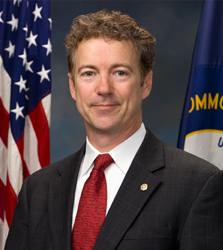
Paul Campaign Is Struggling
The super PAC supporting Kentucky Sen. Rand Paul, America’s Liberty PAC, reported bringing in $3.1 million during the second quarter of 2015. As National Journal reports, that number is lower than any other Republican with a super PAC:
Rand Paul's Super PAC Raises Just $3.1 Million—Smallest Total Yet for 2016 Republican
The main super PAC backing Rand Paul's presidential campaign raised only $3.1 million in the first half of 2015, new Federal Election Commission filings show—the smallest sum of the 10 Republican super PACs to reveal their fundraising figures so far.
The $3.1 million haul over six months is a fraction of the $103 million raised by the super PAC supporting Jeb Bush and even less than the $3.4 million raised by the super PAC supporting Carly Fiorina, who may not make the cut to be on the first debate stage next month.
The relatively low fundraising haul combined with slipping poll numbers has Harry Enten over at FiveThirtyEight.com asking What’s Wrong With Rand Paul’s Campaign?
Something is awry at the Rand Paul campaign. The main super PAC supporting his presidential bid raised just $3.1 million in the first half of 2015, about $100 million less than Right to Rise, a super PAC backing Jeb Bush. In fact, the pro-Paul group’s fundraising total was lower than that of every other major super PAC that is backing a Republican candidate and has announced its totals. On Sunday, a new NBC News/Marist poll showed support for the Kentucky Republican declining to just 4 percent in New Hampshire (compared with 14 percent in February). Numbers like these have people asking, “Has Rand Paul stalled?”
It’s very early. The Iowa caucuses are still six months away, and there’s plenty of time for the Republican nomination race to shift — and shift again. Just look at former U.S. Rep. Ron Paul, Rand Paul’s father, who was polling at only around 8 percent in Iowa at a comparable point in the 2012 primary contest. Ron Paul went on to earn just over 21 percent of the vote in the Hawkeye State.
Still, Rand Paul is at his lowest point in the national polls in over two years.
Enten notes again that it’s early in the campaign and Paul has plenty of time to make a comeback, suggesting part of his slump in support has to do with the media focus on Donald Trump. But he does point to one worrying trend for the Kentucky senator:
The more worrying problem for Paul is his favorability numbers: They’re also dropping. Different pollsters ask about favorability in different ways, but YouGov has checked the popularity of almost every Republican candidate every single week since the beginning of the year. So we can easily compare from poll to poll. Over the first five weeks of 2015, Paul’s favorable rating averaged 62 percent among Republicans. Just 14 percent had an unfavorable view of him. Over the five most recent weeks, though, Paul’s favorable rating has averaged 52 percent, with an unfavorable rating of 27 percent. His net favorability rating (favorable minus unfavorable) has dropped by nearly half, from +48 percentage points to +25 percentage points.
It’s the same story in Iowa and New Hampshire. The Des Moines Register and Quinnipiac University polls found that Paul’s net favorability had dropped in Iowa by 18 and 14 percentage points, respectively, compared with the beginning of the year. In New Hampshire, Paul’s net favorability rating has sunk by 15 percentage points according to the University of New Hampshire and 11 percentage points according to Suffolk University.
The media focus on Trump is likely to fade, but unless Paul is able to find a way to substantially boost his favorability with voters, it won’t matter. How well he manages this will determine whether he can remain a serious contender for president.



